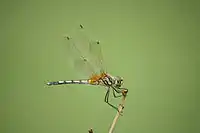Long-legged marsh glider
The long-legged marsh glider[2][3] or dancing dropwing (Trithemis pallidinervis)[4] is a species of dragonfly found in Asia.[1][5]
| Long-legged marsh glider | |
|---|---|
_male_Rajasthan.jpg.webp) | |
| Male in Rajasthan, India | |
| Scientific classification | |
| Domain: | Eukaryota |
| Kingdom: | Animalia |
| Phylum: | Arthropoda |
| Class: | Insecta |
| Order: | Odonata |
| Infraorder: | Anisoptera |
| Family: | Libellulidae |
| Genus: | Trithemis |
| Species: | T. pallidinervis |
| Binomial name | |
| Trithemis pallidinervis (Kirby, 1889) | |
Description
The long-legged marsh glider is a medium-sized yellowish brown dragonfly with long legs. In males, the face is yellow or pale brown in front and iridescent purple above. The eyes are colored reddish brown above, brown on sides and bluish grey below. The thorax is olivaceous brown above with a dark brown triangle. On the sides, it is bright yellowish brown with three black stripes on each side. The legs are black, long, and spidery. The basal half of the femora of the first pair of legs are bright yellow. The wings are transparent with reddish venation. The forewings have amber basal markings. The wings have a golden sheen when viewed from certain angle. Wing spot is black with creamy white ends. The abdomen looks bright yellow in color with black median and lateral stripes. These stripes are confluent at the end of each abdominal segment to enclose a wedge shaped yellow spot. The male varies in colour from yellow (below) to chocolate brown when matured.
The females are similar to males but with a broad abdomen. The only way to distinguish the male from the female is the projection on segment two (secondary genital) and purple frons on the face.[6][7][8][2][3]

 Female
Female.jpg.webp) Male
Male.jpg.webp) Female
Female
Habitat and behavior
This dragonfly is seen near marshes, weedy ponds and lakes where it breeds. It usually perches on tall aquatic weeds or bare ends of shrubs. The long legs are very clearly noticeable at this time. One of the most readily seen dragonflies due to its perching habit and up-winged posture, poised at the tip of swaying reeds.[1][6][2][3]
References
- Subramanian, K.A. (2010). "Trithemis pallidinervis". IUCN Red List of Threatened Species. 2010: e.T167370A6336121. doi:10.2305/IUCN.UK.2010-4.RLTS.T167370A6336121.en. Retrieved 20 November 2021.
- "Trithemis pallidinervis Kirby, 1889". India Biodiversity Portal. Retrieved 2017-02-18.
- "Trithemis pallidinervis Kirby, 1889". Odonata of India, v. 1.00. Indian Foundation for Butterflies. Retrieved 2017-02-18.
- Paulson, D.; Schorr, M.; Abbott, J.; Bota-Sierra, C.; Deliry, C.; Dijkstra, K.-D.; Lozano, F. (2023). "World Odonata List". OdonataCentral, University of Alabama. Retrieved 14 Mar 2023.
- K.A., Subramanian; K.G., Emiliyamma; R., Babu; C., Radhakrishnan; S.S., Talmale (2018). Atlas of Odonata (Insecta) of the Western Ghats, India. Zoological Survey of India. pp. 395–396. ISBN 9788181714954.
- Subramanian, K. A. (2005). Dragonflies and Damselflies of Peninsular India (PDF).
- C FC Lt. Fraser (1936). The Fauna of British India, including Ceylon and Burma, Odonata Vol. III. Red Lion Court, Fleet Street, London: Taylor and Francis. pp. 389-391.
- C FC Lt. Fraser (1924). A Survey of the Odonate (Dragonfly) Fauna of Western India and Descriptions of Thirty New Species (PDF). p. 440.
External links
![]() Data related to Trithemis pallidinervis at Wikispecies
Data related to Trithemis pallidinervis at Wikispecies
![]() Media related to Trithemis pallidinervis at Wikimedia Commons
Media related to Trithemis pallidinervis at Wikimedia Commons
